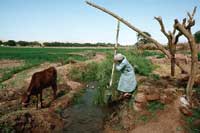|
The Fayoum is a
wonderful area of Egypt with a rich and interesting history. It
is an area where Egyptians often vacation and which is
constantly growing more popular among Europeans. This 692 sq.
mile depression was a lush paradise during prehistoric times.
It's water level was eighty-five meters higher than today
(currently 45 meters below sea level) and the Nile regularly
flooded through the low mountains separating it from the Fayoum.
At 215 square km, the current lake Qaroun remains Egypt's
largest salt water lake. The prehistoric people who lived here
were, at first, nomadic hunters and gatherers, but later began
harvesting plants near the lake. This developed into what is
said to be the earliest agricultural area in the world, where
fences were erected and guarded warehouses built. It has
remained an agriculture center, well known for it's fruits,
vegetables and chickens.
 During the Middle Kingdom, the region achieved considerable
importance and large monuments were built around its shore.
Lahun and Hawara, on the ridge dividing the Fayum from the
Valley, were chosen for the construction of two pyramids, both
of which are now in ruins. The funerary complex at Hawara, built
by the XII Dynasty king Amenhotep III, consisted of a pyramid
and a large funerary temple. Thirteen centuries after its
construction, it was visited by the Greek traveler and historian
Herodotus, who described it as a labyrinth. During the Middle Kingdom, the region achieved considerable
importance and large monuments were built around its shore.
Lahun and Hawara, on the ridge dividing the Fayum from the
Valley, were chosen for the construction of two pyramids, both
of which are now in ruins. The funerary complex at Hawara, built
by the XII Dynasty king Amenhotep III, consisted of a pyramid
and a large funerary temple. Thirteen centuries after its
construction, it was visited by the Greek traveler and historian
Herodotus, who described it as a labyrinth.
Excavated by the British archaeologist Petrie in the years
1888-1910, the site unfortunately revealed almost nothing of the
wonderful building that once must have been there. These were
life-size portraits of people of the community living there,
which were kept in the houses and then placed as funerary masks
on the mummy of the deceased. The Roman cemetery north of Hawara,
instead, yielded one of the most important archaeological
findings of the area, the so-called Fayum Portraits. These Greek
mummy portraits found in the Fayoum are said to be the worlds
first true life portraits, and examples can be found in area
museums.
In addition, a paved road, which has been noted as a landmark of
engineering by engineering societies along side the Eiffel Tower
and Statue of Liberty, is said to be possibly the first paved
road in the world and dates to over 4,500 years. And finally,
the worlds first dam was probably built here in order to control
the Nile floods into the area.
 The peacefulness of the area is a relief from the hustle and
bustle of Cairo, from which it is a brief trip. Bird life still
abounds around Lake Qaroun, bordered by semi-nomadic Bedouin
settlements and fishing villages. Here, on the edge of the
desert, you can sail, windsurf, swim and fish. Other places of
outstanding natural beauty near Fayoum are the hot springs at
Ain al-Siliyin, where you can bath and the waterfalls at Wadi
al-Rayan, 40km towards Bahariya, also suitable for swimming and
picnics. The peacefulness of the area is a relief from the hustle and
bustle of Cairo, from which it is a brief trip. Bird life still
abounds around Lake Qaroun, bordered by semi-nomadic Bedouin
settlements and fishing villages. Here, on the edge of the
desert, you can sail, windsurf, swim and fish. Other places of
outstanding natural beauty near Fayoum are the hot springs at
Ain al-Siliyin, where you can bath and the waterfalls at Wadi
al-Rayan, 40km towards Bahariya, also suitable for swimming and
picnics.
Fayoum is not a true oasis since it depends on Nile water
instead of underground springs or wells. The ancient Bahr Yussef
canal runs through the center of the city and irrigates the
land. Only two hours from Cairo by road, Fayoum is renowned for
its year-round warm climate, numerous water wheels (introduced
by the Ptolemies in the 3rd century) and lush agricultural land.
Cotton, clover, tomatoes, medicinal plants and fruit are all
grown here. The local Souk (market) in Fayoum City sells
copperware, spices and gold jewelry and there is a special
pottery market once a week.
Other interesting archaeological sites are the unusual Middle
Kingdom temple at Qasr el-Sagha, the town of Medinet Madi, with
a Middle Kingdom temple later expanded by the Ptolemies, the
Late Period town of Dionysyas (today called Qasr Qarun) at the
western end of Birket Qarun and the large Roman Bath at Kom
Aushim. Other sites, such as Medinet Fayum (the ancient
Crocodilopolis) or Darb Gerze (the ancient Philadelphia) have
revealed important archaeological evidence. |